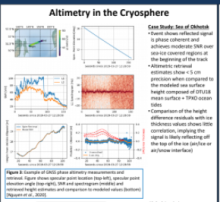Sea Ice Altimetry and Classification using Grazing Angle Reflected GNSS Signals Measured by Spire’s RO Constellation
Vu
Nguyen
Spire Global, Inc.
Poster
In addition to providing thousands of radio occultation measurements per day, Spire Global also collects grazing angle reflections of GNSS RHCP signals using existing radio occultation satellites in a variety of orbits. This new form of GNSS reflectometry (GNSS-R) at shallow angles offers many diverse areas of research and application and demonstrates how modifications to existing GNSS radio occultation receiver software can result in the additional production of valuable measurements for cryospheric research and monitoring. L-band GNSS signals reflected at grazing angles up to 30 degrees are often phase-coherent from electromagnetically smooth surfaces (as typically defined by the Rayleigh criterion) and thus offer the potential for extracting surface properties such as sea ice altimetric height, extent and age. In this presentation, we review the collection and retrieval of sea ice properties using GNSS-R measurements collected from Spire radio occultation satellites. Altimetric estimates exhibiting several centimeter precision over sea ice are highlighted and discussed. Results demonstrating the feasibility of mapping polar ice extent and type (age) using phase coherent GNSS signals are also presented.

Poster PDF